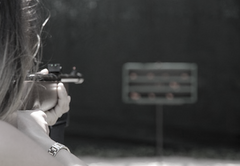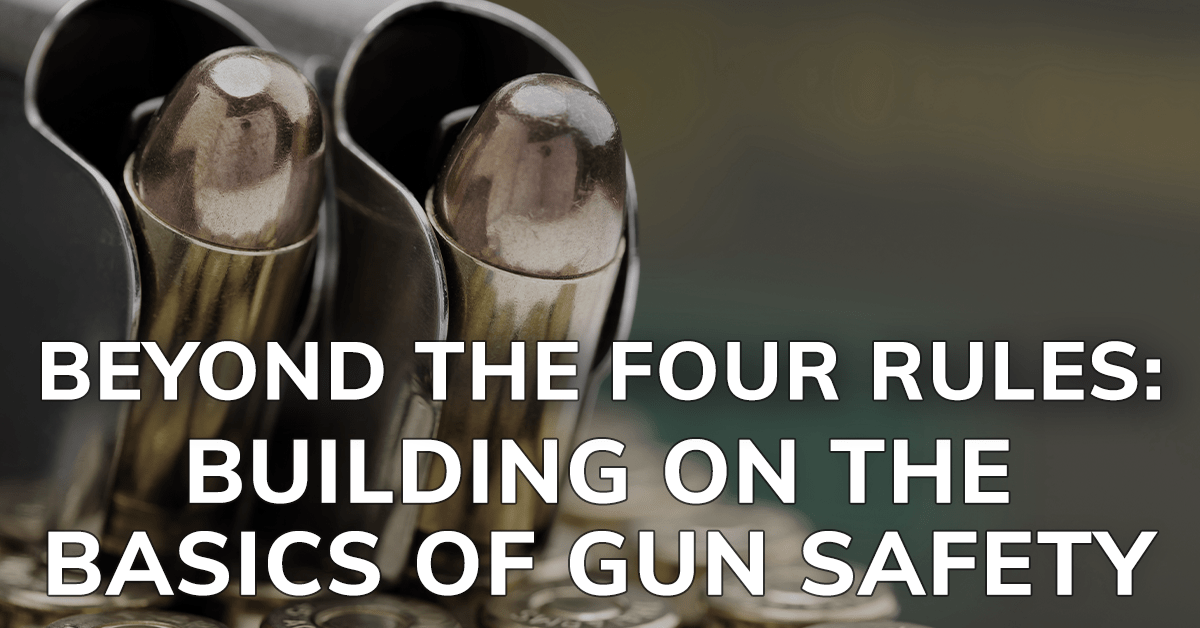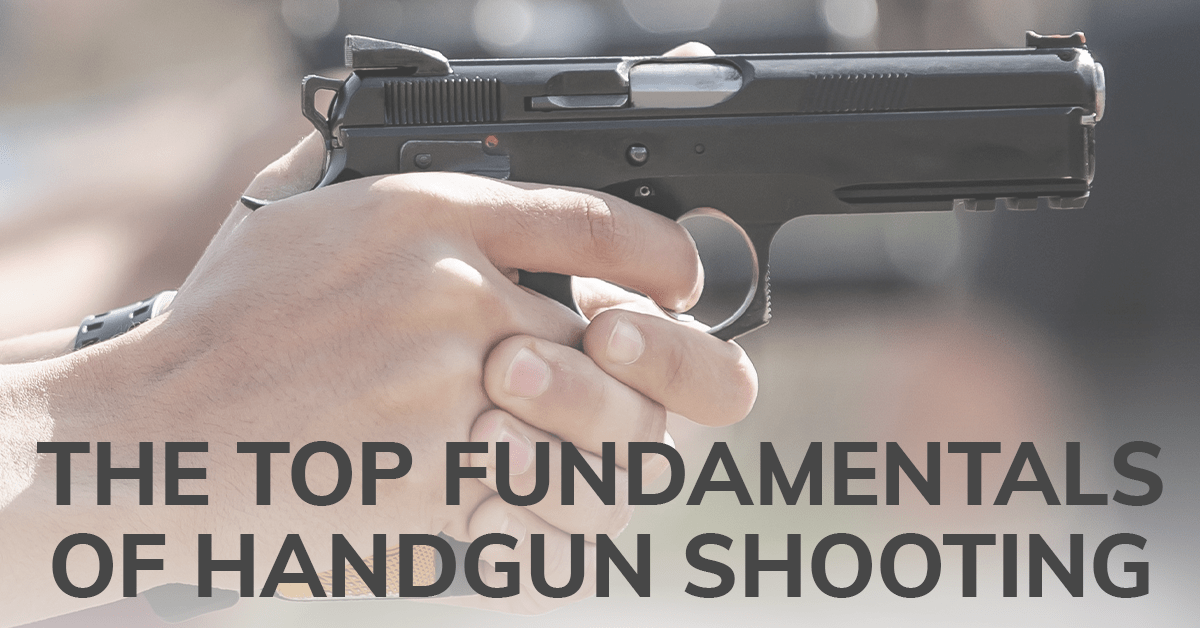Your Cart is Empty
Orders Over $100 Ship FREE (USA)!
Orders Over $100 Ship FREE (USA)!
CONCEALED CARRY
(Apparel with holster pockets or concealed-carry features)
(Apparel with holster pockets or concealed-carry features)
PARTS & GEAR
RANGE STYLE
Gift shopping & not sure about size or style? Give a gift card instead!
Gift shopping & not sure about size or style? Give a gift card instead!
GIFT IDEAS
The entire site is full of products that make great gifts, so browse all of our collections! Still not sure? Give a gift card!
The entire site is full of products that make great gifts, so browse all of our collections! Still not sure? Give a gift card!
EXPLORE
The Four Rules of Gun Safety
3 min read
Many different organizations use a variation of gun safety rules though they are all pretty similar. Some time ago, a firearms expert by the name of Jeff Cooper codified a set of four gun safety rules that are easy to remember and if followed, will result in no accidental shootings.
These four rules are used most often in classes, by instructors, and at gun ranges. Some of the terminologies may confuse beginning shooters. So let’s break it down.
Rule #1 – All guns are always loaded!
 Taken literally, a beginner may feel like it is impossible to unload a firearm. The rule actually means to treat the firearm the same at all times, as if it actually had ammunition in it. Sure, you may have checked it to ensure that it is unloaded. Someone else may have checked it. But do not let that cause you to treat the firearm with any less respect that you would if you knew it had a bullet in it. Far too many accidental discharges and shootings began because the handler believed the firearm to be unloaded when it was not. In summary, act as if the firearm is loaded at all times: At home, at the range, when you are transporting it to your car or when you pick it up to place it in your gun bag.
Taken literally, a beginner may feel like it is impossible to unload a firearm. The rule actually means to treat the firearm the same at all times, as if it actually had ammunition in it. Sure, you may have checked it to ensure that it is unloaded. Someone else may have checked it. But do not let that cause you to treat the firearm with any less respect that you would if you knew it had a bullet in it. Far too many accidental discharges and shootings began because the handler believed the firearm to be unloaded when it was not. In summary, act as if the firearm is loaded at all times: At home, at the range, when you are transporting it to your car or when you pick it up to place it in your gun bag.
Bottom line: Always treat the firearm like it is a loaded firearm.
Rule #2 – Never let the muzzle cover anything which you are not willing to destroy.
 The muzzle of the firearm is the place where the bullet exits on its way to a target. Cover means, essentially, point the gun at someone or something. So, do not point the gun at anyone or anything that you would not want destroyed. Sometimes, this rule is explained as always keep the gun pointed in a safe direction. However, determining safe direction is someplace like a house or a hotel room is not always an easy decision.
The muzzle of the firearm is the place where the bullet exits on its way to a target. Cover means, essentially, point the gun at someone or something. So, do not point the gun at anyone or anything that you would not want destroyed. Sometimes, this rule is explained as always keep the gun pointed in a safe direction. However, determining safe direction is someplace like a house or a hotel room is not always an easy decision.
Bottom line: Never point a firearm at anyone or anything that you do not want to shoot.
Rule #3 – Keep your finger off the trigger until your sights are on target.
 Any time you are handling your firearm, but not yet ready to shoot your firearm, your index finger should be along the frame of the gun, not inside the trigger guard. If you place your finger on the trigger, you risk the chance that you will fire a shot when you did not intend to do so. Keeping your finger indexed along the frame of the gun is a skill that has to be learned and practiced. It does not come naturally.
Any time you are handling your firearm, but not yet ready to shoot your firearm, your index finger should be along the frame of the gun, not inside the trigger guard. If you place your finger on the trigger, you risk the chance that you will fire a shot when you did not intend to do so. Keeping your finger indexed along the frame of the gun is a skill that has to be learned and practiced. It does not come naturally.
Bottom line: The only time your index finger should be on the trigger is when you are ready to fire the shot.
Rule #4 – Be sure of your target and what is beyond it.
 This rule is two-fold. First, target identification or being sure of your target is critical. Don’t assume that bump in the night is caused by a bad guy before you are actually sure that is the case. But not only is it important to identify your target before deciding to shoot, you should know what lies behind your target. If you confront a bad guy in your hallway, make sure that your child’s bedroom is not directly in line behind the bad guy. In a self-defense situation is a public area, you have to make sure that an innocent bystander does not happen to be behind your target.
This rule is two-fold. First, target identification or being sure of your target is critical. Don’t assume that bump in the night is caused by a bad guy before you are actually sure that is the case. But not only is it important to identify your target before deciding to shoot, you should know what lies behind your target. If you confront a bad guy in your hallway, make sure that your child’s bedroom is not directly in line behind the bad guy. In a self-defense situation is a public area, you have to make sure that an innocent bystander does not happen to be behind your target.
Bottom line: Make sure of your target and what might be behind your target before you fire the shot.
It’s a good idea to memorize these four safety rules and even recite them to yourself before you begin to shoot every time you go to a range. They should be second nature and become the way you handle a firearm each and every time. Following these rules will ensure that there will be no accidents when you handle your firearms whether you are at the range shooting, at home cleaning and maintaining your gun or even holstering your concealed carry firearm.
Never forget that safety is a full-time endeavor when it comes to firearms.
Also in Skill Building: The Fundamentals

Beyond the Four Rules: Building on the Basics of Gun Safety
3 min read
The 4 main rules of gun safety are a good starting point, but there's more to be aware of. Here are a few some tips to stay safe with your firearm.
Read More
Tips for Drawing From a Holster — A Beginner's Guide
3 min read
Drawing from a holster is an important competency, especially if you carry a gun. Here are a few tips to help you feel more confident when mastering this skill.
Read More
The Top Fundamentals of Handgun Shooting
3 min read
Do you know what shooting fundamentals are and which skills you should be working on right after you purchase a gun? Here's our list of three of handgun fundamentals you should master right away.
Read More